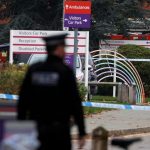The R rate in England has increased and is now estimated to be between 1.2 to 1.5, according to the latest figures from the UK Health Security Agency – as new data shows the Omicron strain sweeping across the nation.
The reproduction figure means that for every 10 people with coronavirus they will, on average, infect between 12 to 15 people.
On 23 December, The R rate for England was between 1.0 to 1.2 with the growth rate range between 0% to +3% per day.
As of 7 January, England now has a growth rate range of between +3% to +6% per day.
Earlier, First Minister Mark Drakeford accused Boris Johnson off failing to take the necessary action to protect England from the Omicron wave of coronavirus.
He told a Welsh government news conference the Omicron “storm” had hit Wales as he confirmed the continuation of restrictions.
Live COVID updates from across the UK and world
COVID: Another 179,756 daily coronavirus cases and 231 deaths reported in UK
COVID-19: Leap in interest for holidays as testing restrictions are relaxed
COVID: People turned away from hospital and forced to barter for food in China’s latest lockdowns
“Wales is taking action, as is Scotland, as is Northern Ireland, and as are countries right across Europe, and right across the globe,” he said.
“The one country that stands out as not taking action to protect its population is England,” he continued, describing it as a “global outlier” in the fight against Omicron.
Please use Chrome browser for a more accessible video player
NHS staff absences due to COVID in England triple
The number of NHS staff in England off work or isolating due to COVID has more than tripled since the start of December, according to the latest data from NHS England.
On 2 January, a total of 39,142 personnel in acute NHS trusts were absent compared to 12,508 on 1 December.
The new figure is also up 59% on the previous week’s total of 24,632 on Boxing Day, peaking at 40,654 on 30 December.
This was five days after Christmas, when many people would have been mixing with their families.
The total includes staff who were ill with coronavirus or who were having to self-isolate.
Dr Chaand Nagpaul, council chairman of the British Medical Association (BMA), told Sky News some NHS staff still could not access the lateral flow tests needed to allow them to return to work after seven days of isolation instead of 10 days.
More than 87,000 NHS staff were off ill or isolating on 30 December
Additional data from NHS England on staff absences in hospital trusts for all sickness reasons or self-isolation shows that during the two weeks from 20 December to 2 January, absences were highest on 30 December.
On this day alone, more than 87,000 NHS workers were absent.
By comparison, absences had been hovering at around 60,000 in late November and early December.
As of Thursday, 17 hospital trusts in England had declared critical incidents – signalling there are fears that priority services cannot be safely delivered.
NHS ambulance handovers
The number of delays of more than 60 minutes also peaked on 30 December with a a total of 1,443, according to new NHS England figures.
This compares to 454 on Boxing Day and 972 on 2 January 2022.
Some 10% of patients waited more than an hour to be handed over.
Nearly one in four patients arriving at hospitals in England by ambulance last week waited at least 30 minutes to be handed over to A&E departments.
Some 19,099 delays of half an hour or more were recorded across all hospital trusts in the seven days to 2 January.
This equated to 23% of all arrivals by ambulance, up from 13% the previous week and equalling the level recorded in early December.
Subscribe to the Daily podcast on Apple Podcasts, Google Podcasts, Spotify, Spreaker
Two major incidents declared
The latest impact of the COVID-19 pandemic has prompted the public and emergency services in two areas to declare a major incident.
Staffordshire Resilience Forum is made up of multiple agencies such as the NHS, fire and rescue Service, police and councils.
The recent Omicron surge has led to the decision – the third time since the beginning of the pandemic that a major incident has been declared in the area.
Northamptonshire has also declared a system-wide major incident, with hospitals, care homes and emergency services subject to a shortage of staff and facing increased demand because of coronavirus, Northamptonshire Police said.
Patients with COVID
Of the 13,045 patients with coronavirus in NHS hospital trusts in England on 4 January, a total of 8,200 (63%) were being treated primarily for COVID-19, according to data from NHS England.
This is down from 67% a week earlier and 74% at the start of December.
The number being treated primarily for COVID rose from 5,578 on 28 December to 8,200 on 4 January (an increase of 47%), while those with coronavirus but being treated primarily for something else rose from 2,743 to 4,845 (a jump of 77%).
Please use Chrome browser for a more accessible video player
111 calls
Almost 80,000 more 111 calls were answered this week than the previous week.
That’s up from the 71,000 the week before and 50,000 more than this winter’s previous high of 336,000 for the week ending 19 December.
Impact on hospital beds
The NHS says almost 3,000 critical care and general acute beds have been closed due to COVID or norovirus over the last week and it is still struggling to discharge patients who are medically fit to return home.
There are some 10,000 of these still in hospital but cannot be sent home because there is no community care available for them.
Again this is largely driven by the surge in COVID infections.
Booster vaccines
A total of 231,856 booster and third doses of COVID-19 vaccine were reported across the UK on Thursday, new figures from the UK’s four health agencies show.
More than 35 million booster and third doses have now been delivered in the UK, with just over one million in the past seven days.
Nearly 66% of all adults in the UK have now received a booster or third dose.
The Omicron-driven staffing crisis in the NHS is deepening at the same time demand for services is rising.
The latest figures from NHS England show more staff were absent this week, than they were during the previous seven days. The figure has grown from 71,000 to 80,000 – that’s an increase of 13%.
It is why at least 17 NHS Trusts have declared critical incidents this week. They do not have enough staff to function normally and guarantee patient safety.
It is the same reason why hospitals across the Greater Manchester region have been forced to postpone non urgent care.
Almost half of these absences are because of COVID and, again, here we can see a rise in the numbers.
This week almost half of all NHS staff absences, some 44%, were because of the spike in Omicron infections. That’s up by 22% from the 36,000 staff who called in sick the week before.
So while more staff are being forced to isolate the demand on services continues to go up.
Community infections are rising, more people are falling sick and looking for medical help.
Almost 80,000 more 111 calls were answered this week than the week before.
So we can see clearly how the Omicrom wave is driving up demand on the NHS right across the system at the same time drastically impacting its staffing levels.
The pressure continues to build and hospitals have not even seen the first wave of winter flu cases. This might, hopefully, be mitigated by mask wearing.
Social impact
Around six in 10 adults (63%) reported they avoided physical contact with others outside their home in the past seven days, according to figures from the Office for National Statistics.
This was prevalent among older adults compared to younger groups: 74% of those aged 70 years and over, 66% of those aged 50 to 69 years, 60% of those aged 30 to 49 years, and 52% of those aged 16 to 29 years.
However, of those that did see others (excluding for work or education), around seven in 10 (69%) socialised indoors, while almost half (47%) met up outdoors.
A higher number of younger adults met up or socialised outdoors with others outside their household (64% of those aged 16 to 29 years) compared with older adults (43% of those aged 30 to 49 years, 44% of those aged 50 to 69 years, and 41% of those aged 70 years and over).
COVID infection rate
The Office for National Statistics has confirmed more than three million people had coronavirus in the last week of 2021.
The ONS infection survey for shows 3.7 million people were infected with COVID – up from 2.3 million in the week before Christmas.






















